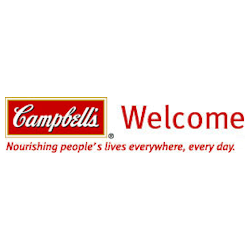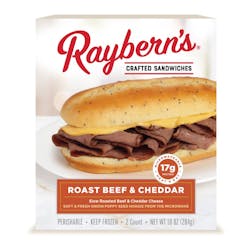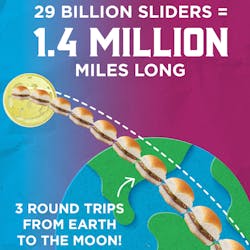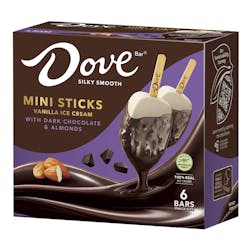Campbell Soup Co. reported its results for the second quarter of fiscal 2012.
Net earnings for the quarter ended Jan. 29, 2012, were $205 million, or $0.64 per share, compared with $239 million, or $0.71 per share, in the prior year. The current quarter’s reported net earnings included charges associated with the previously announced June 2011 restructuring program. Excluding items impacting comparability in the current year, adjusted net earnings decreased 13 percent to $207 million, and adjusted net earnings per share decreased 10 percent to $0.64 in the current quarter. A detailed reconciliation of adjusted financial information to the reported information is included at the end of this news release.
Denise Morrison, Campbell’s president and chief executive officer, said in a prepared statement, “At the midpoint of our fiscal year, we are focused outward on consumers and on executing against our three strategies to return Campbell to sustainable, profitable net sales growth. As we said last July, implementing our new strategic direction will require substantial investment to fund brand-building efforts and a step change in innovation, particularly in U.S. Simple Meals. We are confident that these changes will position Campbell for future success.
“Six months into our transition, we continue to make progress in stabilizing overall U.S. Soup profits, achieving the fourth consecutive quarter of profit growth for this business. We expect improved sales in the second half, as we continue to shift our emphasis to brand building efforts that will drive consumer usage.”
Morrison continued, “Sales gains in our U.S. beverages business, where we have a solid ongoing innovation program, outpaced category growth. Trends in this business improved since the launch of our new advertising campaign in October. Significant cost inflation and marketing investments negatively impacted profitability in both the quarter and the half.
“Across our portfolio, we increased marketing spending this quarter, consistent with our plan to shift our emphasis to longer-term brand-building activities. Advertising and consumer promotion expense rose 6 percent as we invested in key brands.”
Morrison concluded, “We are executing a strategic turnaround in an environment of weak volume and high inflation across the food industry. Our first half has been impacted by headwinds in our beverages and Australian businesses, but we continue to make progress against our key growth strategies. In the second half, we expect improved trends in our beverages and Australian businesses, and in U.S. Soup, we will begin to cycle our change in discounting, providing an opportunity for better sales performance. We will continue to invest in brand building and innovation, and we are on track to achieve our full-year guidance.”
The company confirmed its previous fiscal 2012 guidance. Campbell expects net sales growth to be between 0 and 2 percent, a decline in adjusted EBIT of between 9 and 7 percent and a decline in adjusted EPS of between 7 and 5 percent, putting adjusted EPS in the range of $2.35 to $2.42, from the 2011 adjusted base of $2.54.
For the second quarter, sales decreased 1 percent to $2.112 billion. The change in sales for the quarter reflected the following factors:
- Volume and mix subtracted 3 percent;
- Price and sales allowances added 3 percent;
- Increased promotional spending subtracted 1 percent.
Gross margin was 38.4 percent compared with 39.4 percent a year ago. The decrease in gross margin percentage was primarily due to cost inflation and negative mix, partly offset by higher selling prices and productivity improvements.
Marketing and selling expenses increased 2 percent to $297 million compared with $291 million in the prior year, primarily due to higher advertising and consumer promotion expenses, partly offset by lower selling expenses. Advertising and consumer promotion expenses increased 6 percent, reflecting brand-building investments across several businesses.
Administrative expenses decreased $2 million to $152 million, reflecting the benefit of cost savings from restructuring initiatives, partly offset by higher incentive compensation and benefit costs.
EBIT was $329 million compared with $359 million in the prior-year quarter. Excluding items impacting comparability, adjusted EBIT in the current quarter was $332 million. Adjusted EBIT declined 8 percent primarily due to cost inflation and lower volumes, partly offset by higher selling prices and productivity savings.
The tax rate in the quarter was 33.7 percent compared with 27.1 percent in the prior year. The prior-year rate benefitted from incremental tax credits associated with foreign earnings.
Adjusted net earnings per share were $0.64 in the current quarter compared with net earnings per share of $0.71 in the prior-year quarter, a decrease of 10 percent. In addition to the impact of lower EBIT, the decline reflected the impact of a significant increase in the tax rate compared with the prior-year quarter, partly offset by fewer shares outstanding.
Net earnings for the first half were $470 million, or $1.45 per share, compared with $518 million, or $1.53 per share, in the year-ago period. Excluding items impacting comparability in the current-year period, adjusted net earnings declined 9 percent to $473 million. Including the benefit of fewer shares outstanding, adjusted net earnings per share declined 5 percent to $1.46.
For the first half of fiscal 2012, sales were $4.273 billion, a decrease of 1 percent from the year-ago period. The change in sales for the period reflected the following factors:
- Volume and mix subtracted 4 percent;
- Price and sales allowances added 3 percent;
- Increased promotional spending subtracted 1 percent;
- Currency added 1 percent.
Gross margin was 39.0 percent compared with 40.3 percent a year ago. The decrease in gross margin percentage was primarily due to cost inflation and negative mix, partly offset by higher selling prices and productivity improvements.
Marketing and selling expenses decreased 2 percent to $558 million, primarily due to lower advertising and consumer promotion expenses and lower selling expenses, partly offset by the impact of currency.
Administrative expenses increased $3 million to $297 million, primarily due to higher incentive compensation and benefit costs and currency, partly offset by savings associated with the restructuring initiative.
EBIT was $745 million compared with $803 million in the prior year. Excluding items in the current year impacting comparability, adjusted EBIT declined 7 percent to $750 million. The decline in EBIT was due to cost inflation and lower volumes, partly offset by higher selling prices and productivity savings.
Cash flow from operations was $478 million compared with $483 million in the year-ago period. The decline reflected the impact of lower cash earnings, partly offset by the benefit of lower pension contributions.
Utilizing positive cash flow, Campbell repurchased 5.3 million shares for $173 million during the first half of 2012. These purchases were made under the company’s $1 billion strategic share repurchase program announced in June 2011 and the ongoing practice of buying back shares sufficient to offset those issued under incentive compensation plans.
Sales for U.S. Simple Meals were $824 million for the second quarter, a decrease of 2 percent compared to the year-ago period. A breakdown of the change in sales follows:
- Volume and mix subtracted 5 percent;
- Price and sales allowances added 3 percent;
- U.S. Soup sales declined 2 percent compared to the year-ago quarter.
Sales of “Campbell’s” condensed soups increased 5 percent, with increases in both cooking and eating varieties. Sales of cooking varieties benefitted from a strong holiday period.
Sales of ready-to-serve soups decreased 12 percent. The benefit of higher selling prices and lower promotional spending was more than offset by lower volumes. The introduction of “Campbell’s Slow Kettle” soups positively impacted sales performance in the quarter.
Broth sales rose 3 percent, reflecting volume gains in aseptically packaged broths and the benefit of new items, including “Swanson Flavor Boost.”
U.S. Sauces sales declined 2 percent compared to the year-ago quarter. Sales of “Prego” pasta sauce increased 6 percent as increased advertising support and promotional activity drove strong volume gains. Sales of “Pace” Mexican sauces declined 7 percent reflecting the impact of increased private label competitive activity.
U.S. Simple Meals operating earnings were $174 million compared with $177 million in the prior-year period. The decline in operating earnings reflected lower earnings in U.S. Sauces, partly offset by earnings gains in U.S. Soup. For the segment, lower volumes and increased advertising and consumer promotion expenses were partly offset by an increase in gross margin percentage and lower selling and administrative expenses.
For the first half, U.S. Soup sales declined 3 percent primarily due to an 11-percent decrease in ready-to-serve soups. Sales of condensed soups were comparable to the prior year, while sales of broth increased 4 percent.
U.S. Simple Meals operating earnings were $434 million in the first half compared with $417 million in the year-ago period, an increase of 4 percent. The increase in operating earnings, driven primarily by gains in U.S. Soup, was due to higher selling prices, productivity savings and lower promotional spending, partly offset by lower volumes and cost inflation.
Sales for global baking and snacking were $526 million for the second quarter, comparable to the prior-year quarter. Sales were impacted by the following factors:
- Volume and mix subtracted 4 percent;
- Price and sales allowances added 5 percent;
- Increased promotional spending subtracted 2 percent;
- Currency added 1 percent.
Further details of sales results included the following:
Sales of “Pepperidge Farm” products increased slightly as the benefit of higher selling prices was mostly offset by lower volumes.
In cookies and crackers, sales increased as double-digit growth in “Goldfish” snack crackers was partly offset by declines in cookies.
Bakery sales declined slightly.
Excluding the favorable impact of currency, sales at Arnott’s declined primarily due to the impact of increased promotional spending and lower volumes, partly offset by higher selling prices. The volume performance continued to be negatively impacted by an increase in promoted and non-promoted price points at retail and a weak consumer environment.
Operating earnings for the quarter were $71 million compared with $81 million in the prior year. The 12-percent decline was primarily due to cost inflation and increased promotional spending, partly offset by higher selling prices.
For the first half, sales increased 2 percent to $1.094 billion. A breakdown of the change in sales follows:
- Volume and mix subtracted 4 percent;
- Price and sales allowances added 5 percent;
- Increased promotional spending subtracted 1 percent;
- Currency added 2 percent.
Operating earnings in the first half decreased 12 percent to $159 million compared with $181 million in the year-ago period, primarily due to cost inflation, increased promotional spending and lower volumes, partly offset by higher selling prices and productivity improvements.
Sales for international Simple Meals and beverages were $402 million for the second quarter, a decrease of 5 percent. The change in sales reflected the following factors:
- Volume and mix subtracted 5 percent;
- Price and sales allowances added 2 percent;
- Increased promotional spending subtracted 1 percent;
- Currency subtracted 1 percent.
The sales decline was primarily due to the performance of the businesses in Europe and Canada, partly offset by gains in the Asia Pacific region and Latin America.
In Europe, sales decreased primarily due to volume declines in France and Germany.
In Canada, sales decreased primarily due to declines in soup.
In the Asia Pacific region, sales increased due to the impact of currency and growth in Japan and Malaysia, partially offset by declines in Australia soup.
Operating earnings were $58 million compared with $69 million in the year-ago period. The decrease in operating earnings reflected the increased costs associated with the company’s market expansion in China and lower earnings in Europe and Canada.
For the first half, sales decreased 4 percent to $761 million. A breakdown of the change in sales follows:
- Volume and mix subtracted 7 percent;
- Price and sales allowances added 2 percent;
- Currency added 1 percent.
The sales decline reflected lower sales in Canada and the European region.
Operating earnings fell to $101 million compared with $120 million in the year-ago period. The decrease in operating earnings was primarily due to lower earnings in Canada and the increased costs associated with the company’s market expansion in China.
Sales for U.S. beverages were $187 million for the second quarter, an increase of 4 percent compared with the year-ago period. A breakdown of the change in sales follows:
- Volume and mix added 2 percent;
- Price and sales allowances added 1 percent;
- Decreased promotional spending added 1 percent.
Sales gains, which outpaced category growth, were driven by growth in “V8 Splash” juice drinks and “V8 V-Fusion” juice, partly offset by a decline in “V8” vegetable juice. Sales benefitted from the launch of new items, including “V8 V-Fusion” Smoothies, and higher levels of advertising investment supporting the new campaign featuring Jackie Chan.
Operating earnings for the quarter were $34 million compared with $43 million in the year-ago period. The decline in earnings reflected the impact of significant cost inflation primarily in juice concentrates and packaging materials, and increased advertising expense, partly offset by productivity gains.
For the first half, sales were comparable to the prior period.
Volume and mix added 2 percent.
Increased promotional spending subtracted 2 percent.
Sales of both “V8 Splash” juice drinks and “V8 V-Fusion” juice increased, while sales of “V8” vegetable juice declined.
Operating earnings declined to $64 million from $98 million, primarily due to cost inflation, increased promotional spending and higher advertising, partly offset by productivity gains.
North American foodservice sales were $173 million for the second quarter, an increase of 9 percent compared with a year ago. A breakdown of the change in sales follows:
- Volume and mix added 7 percent;
- Price and sales allowances added 2 percent;
- Sales increased primarily due to volume-driven gains in fresh chilled soup sold at retail.
Operating earnings increased 33 percent to $28 million from $21 million. The increase in operating earnings was primarily driven by volume gains, higher selling prices and productivity improvements, partly offset by cost inflation.
For the first half, sales increased 8 percent to $335 million. A breakdown of the change in sales follows:
- Volume and mix added 5 percent;
- Price and sales allowances added 3 percent
Operating earnings were $55 million compared with $44 million in the year-ago period. The increase in operating earnings was primarily driven by higher selling prices, volume gains and productivity improvements, partly offset by cost inflation.





